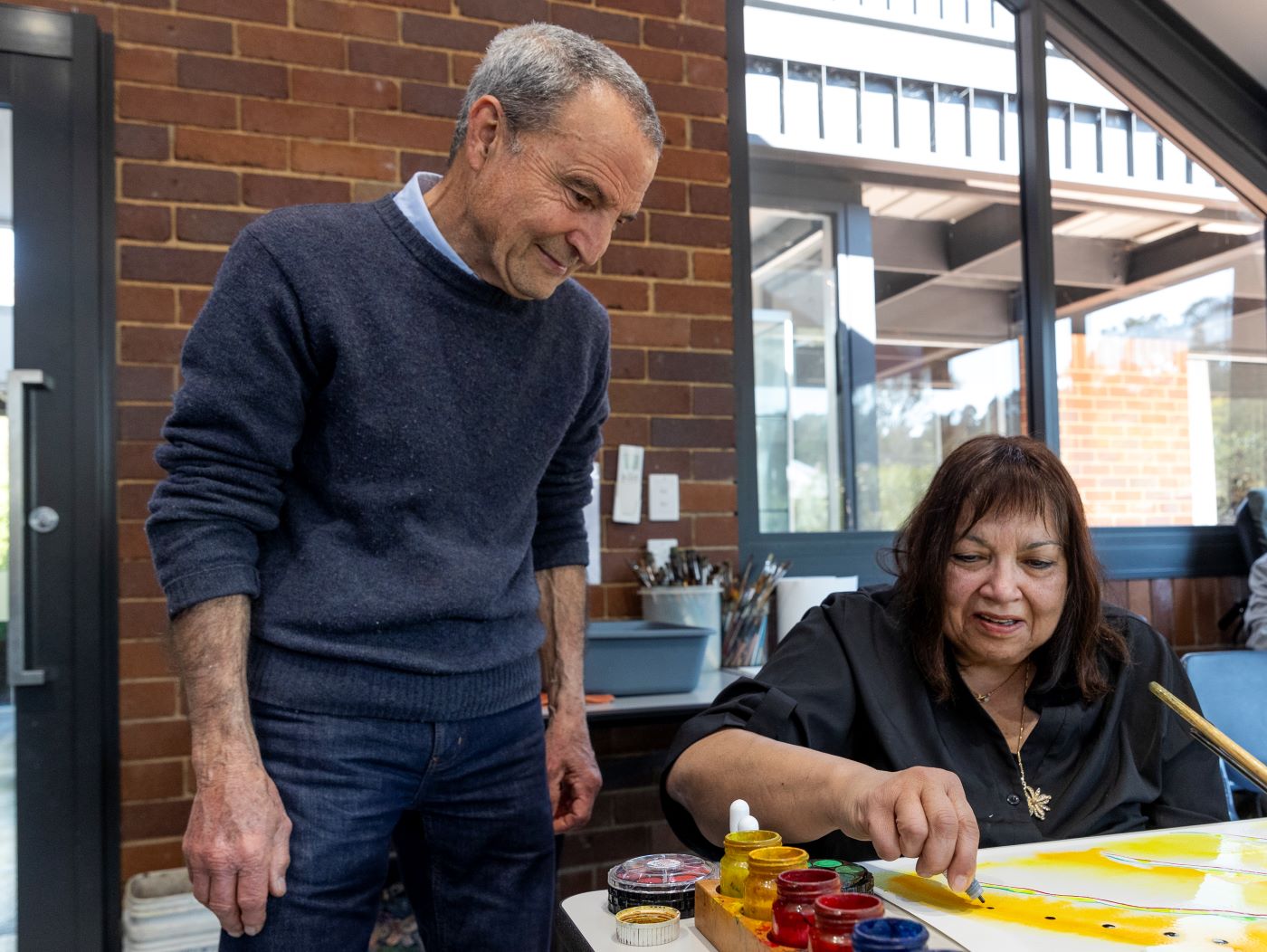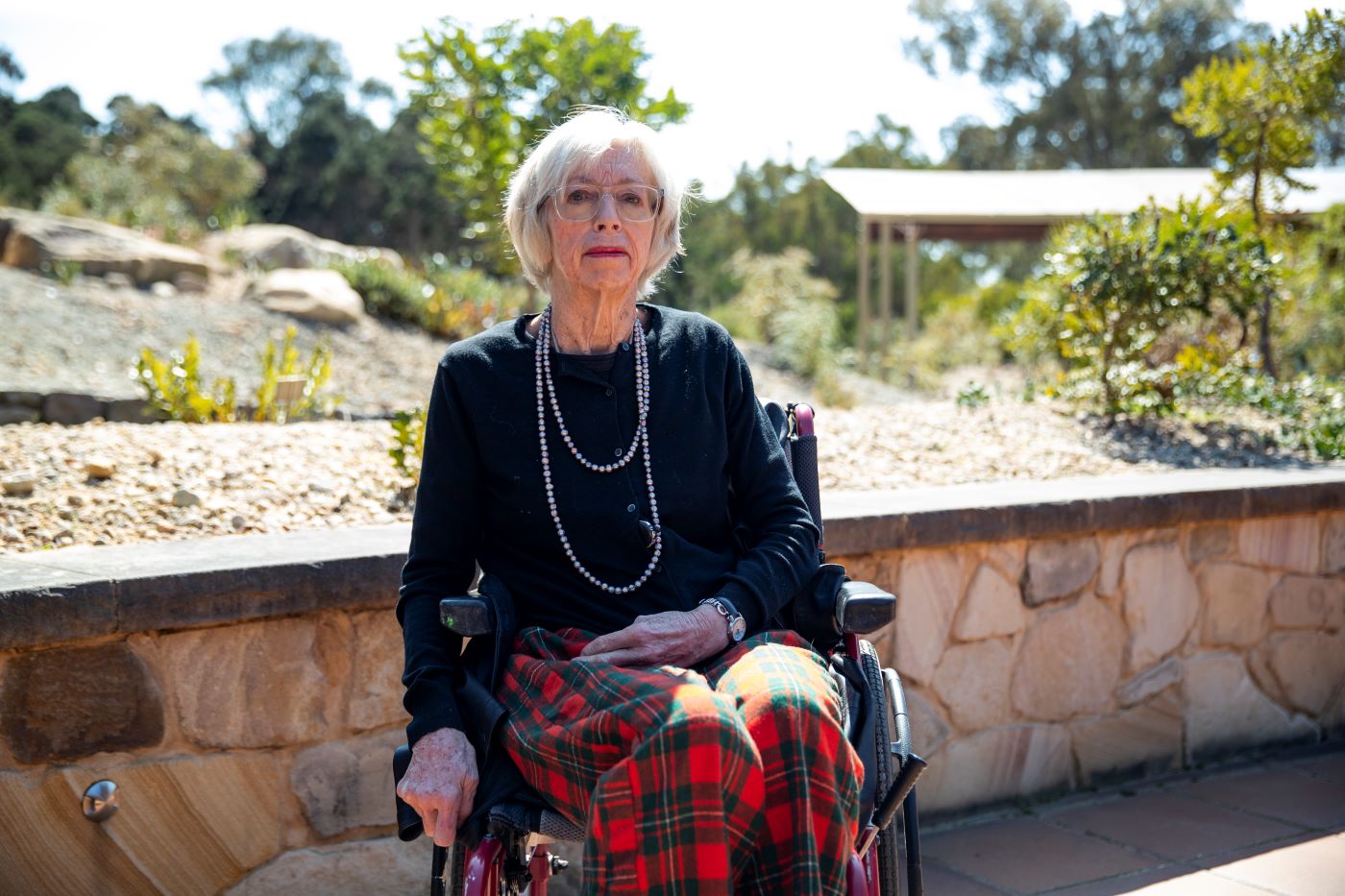In the glow of the morning sun colours flow as paint-covered brushes drape across damp pages creating works of memories and moments in time. This is how every Friday morning goes at the Tingey Painting with Parkinsons program.
Each week, 12-15 participants enter the Banksia Centre at the Australian National Botanic Gardens where they begin with a few physical exercises ahead of discussing the day’s theme. Facilitators and occasional art therapists are there to guide and assist the painters in their creations as music plays in the background.
Creating a welcoming, ambient space is vital and the use of music – mainly classical – tends to immerse the painter and inspire creations.
“The paintings are not about an observational account, they are about a felt experience in relation to a poem or a piece of music,” says John Pratt, program coordinator.
Once a month, a musician from the Canberra Symphony Orchestra joins the session to play live. John says it is interesting to witness how different sounds and instruments impact the paintings being crafted.
“Music is a mystery in terms of the way each person responds, often it evokes a different memory or experience, and the paintings in some way capture the experience the music evokes.”

Celebrating its 30th anniversary this year, the program was launched by Nancy Tingey, an artist who was awarded the Churchill Fellowship to research neurology and art therapy. Nancy’s husband Bob, a geologist, was diagnosed with Parkinson’s in 1987. In 1993, he took over as President of Parkinson’s ACT, and Nancy started the painting group.
From there it was research and travelling around the world to uncover how the arts could help people like Bob. Nancy started the sessions with a theme or discussion that awakened the right side of the brain, the creative side.
“The programs she researched showed there was an evident benefit that was involved. For the people who were immersed in a creative experience, the symptoms of the Parkinson’s condition were often reduced significantly,” says John.
Taking the reins in 1999, John has witnessed the incredible impact the program has on its participants. He says people often come in with constrained body language and leave with more fluidity in their movements.
“The enhancement and affirmation that happens within each program there is a noticeable uplift,” says John. “When you have an experience like that, it may be just once a week, but it permeates through the week too.”
Working with watercolours on a dampened page allows for ease of movement and fluidity, John says there is a beautiful collaboration of materials which inspires excitement and awe for the painters.
“There’s a certain definitiveness and assertion when a line is made onto dry paper, there is a limitation that’s set by that line,” he explains. “Working with watercolour, particularly on a fluid surface, there’s this whole magical kind of evocation that comes through, enabling a certain realisation to happen for each of the participants.”
Participants range from those who have recently received a diagnosis to those who have been living with Parkinson’s for twenty years. No artistic experience is needed, John says many people coming for the first time haven’t painted since primary school.
“Often, they say there was some offhand remark by a teacher which has destroyed their confidence… There is a certain hesitance to start with but then there is a confidence and excitement that happens when they are involved in the work itself.”



An artist himself, John holds exhibitions and previously taught at the ANU School of Art but has found the art world worrying at times as it can be elitist or demand a certain status. Whereas an experience like this program enables and encourages painters to be expressive without critique or judgment, he is honoured to play a role in it.
“The magical aspect of the imagery that emerges but also the impact that it has on the participants, it is just a really rewarding experience to witness,” he smiles.
It is more than just a creative outlet, the Tingey Painting for Parkinsons program encourages social connection. At the end of each session, everyone talks about what was created that day.
“The discussion at the end of the session has an interesting contribution from each of the participants about what they have painted and also their response or interpretation of what someone else has done too. A communal sense of participation.”
From its humble beginnings here in Canberra, the program has now been implemented in different countries across the globe, recognised for the positive impacts it provides. Recognition close to home continues as John is in the running for the Westfield Local Heroes program at Westfield Woden.
However, John says he is just the face of the program; if he were to take home the award, the funds would go toward covering the program’s costs, including rent, supplies, and paying their art therapists.
“It would significantly help fund the art materials themselves. The paper we work on is quite expensive, it is a heavy watercolour paper and a wonderful contributor to the way the images evolve.”
Experiencing the benefits of the program first-hand, Sue Green has been attending the sessions each Friday morning for the past three years.
“Every time it is a great pleasure to come. It is not only painting we also have music; it is like dying and going to heaven – you’re both painting and listening to music, it is just fabulous,” she smiles.

An art lover, Sue says she never has, nor will she ever be a great artist but that it doesn’t matter, it is the pleasure of the painting itself, and the company that keeps her coming back.
“All the people in the program become friends, I didn’t know anyone at first but they’re all friends now. We talk about all sorts of things. We don’t discuss Parkinson’s much; we occasionally curse it and talk about it, but the program isn’t about Parkinson’s—it’s about life and fun.”
Sue now lives in an aged care facility where she shares the work she has created and the skills she has gained with other residents. She encourages others with painting classes she hosts and uses her own works as wrapping paper and gifts to friends.
“I like to give them away to people. If they express even a tiny bit of interest, they get a painting.”
Creating abstract and conventional pieces of work, Sue hopes that others will see that there are plenty of things you can do, even with a diagnosis like Parkinson’s. There is a key to it, she says, to keep positive and have as much fun as possible.
“The program gives you hope that life can be fun and if there is no fun in life, what is it all about? It is good to not hide yourself away, if you can’t walk or whatever your disability is, I think you should get out as much as you can and it’s possible,” smiles Sue.
Find out more about the Tingey Painting with Parkinsons program; paintingwithparkinsons.org.au
Canberra Daily is keen to hear from you about a story idea in the Canberra and surrounding region. Click here to submit a news tip.



